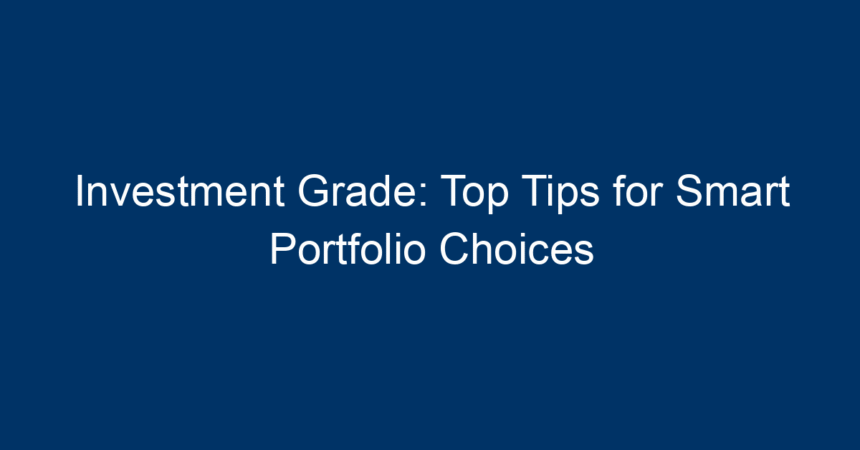In the world of investing, the term investment grade is synonymous with safety and reliability. As investors seek out assets that promise stable returns with lower risk profiles, understanding the nuances of investment-grade choices becomes essential. This article aims to guide you through essential strategies for making smart portfolio choices, maximizing returns while minimizing risks.
What Does Investment Grade Mean?
Investment grade refers to a classification for bonds and other investment vehicles issued by corporations or governments. These assets are rated by credit rating agencies, such as Moody’s or Standard & Poor’s, based on their creditworthiness. Bonds rated ‘BBB’ or higher typically fall into the investment-grade category. This categorization signifies that these investments are deemed relatively safe and likely to fulfill their debt obligations.
Importance of Investment Grade Ratings
Understanding investment-grade ratings is crucial for various reasons:
- Risk Assessment: Investment-grade assets are less likely to default, making them a favored choice among conservative investors.
- Portfolio Stability: Including these assets can provide stability, especially during market volatility.
- Yield Considerations: Although lower-risk assets typically offer lower yields, they can enhance an investor’s overall portfolio performance when combined with higher-risk investments.
Top Tips for Building an Investment-Grade Portfolio
1. Assess Your Risk Tolerance
Before diving into investment-grade assets, it’s essential to assess your risk tolerance. This initial step will dictate your choice of assets and help you maintain a balanced portfolio. Use tools like risk assessment questionnaires or consult a financial advisor for a more tailored approach.
2. Diversify Your Holdings
Diversification is a key principle of investing, aiming to reduce risk by spreading investments across various asset classes. When it comes to investment-grade assets:
- Bonds: Consider a mix of corporate, municipal, and government bonds.
- Stocks: Look for blue-chip stocks that carry investment grade ratings.
- Funds: Invest in ETFs or mutual funds that focus on investment-grade assets to further diversify your holdings.
3. Keep an Eye on Economic Indicators
Macroeconomic indicators can significantly influence the performance of investment-grade assets. Watch for patterns in interest rates, inflation, and unemployment figures. Typically, rising interest rates can negatively affect bond prices, so remain vigilant about market conditions.
4. Research Credit Ratings
Not all investment-grade assets are created equal. Always research the credit ratings of bonds or companies before investing. The nuances between ‘BBB’ and ‘AA’ ratings can have implications for risk and returns. Make sure to check for:
- Credit Rating Agency Projections: Follow updates and changes in ratings.
- Company Financial Health: Look beyond ratings; analyze financial statements and debt levels.
5. Fixate on Quality Over Quantity
In the pursuit of a balanced portfolio, prioritize quality investment-grade assets over a large number of mediocre ones. Investing in a few high-quality bonds or stocks can yield better long-term results than a broad selection of lower-quality assets.
6. Consider Duration Risk
When investing in bonds, understanding duration risk—how price sensitivity fluctuates with interest rates—is essential. Shorter-duration bonds might offer less risk and better protection against rising rates, while longer-duration bonds can provide higher yields.
7. Stay Updated on Market Trends
The investment landscape is continuously evolving. Regularly monitor financial news, economic reports, and market analyses to stay informed. Platforms like Bloomberg, CNBC, or financial blogs can provide valuable insights and trends that might affect your investment-grade assets.
8. Rebalance Your Portfolio Regularly
Markets can be volatile, requiring you to adapt your portfolio to maintain your desired asset allocation. Schedule regular reviews (quarterly or bi-annually) to assess your investment-grade assets. This helps ensure you stay aligned with your investment goals and risk tolerance.
Investment-Grade vs. Non-Investment-Grade
Understanding the differences between investment-grade and non-investment-grade assets is crucial for informed decision-making:
- Risk: Investment-grade assets pose lower risk compared to their non-investment-grade counterparts, which come with a higher likelihood of default.
- Return: While investment-grade assets may offer lower yields, they are generally more stable, making them ideal for conservative investors.
- Market Behavior: Investment-grade assets tend to perform better during economic downturns, offering a cushion to portfolios.
Examples of Investment-Grade Assets
- Corporate Bonds: Bonds issued by companies rated ‘BBB’ or higher. These are relatively safe investments.
- Government Debt: U.S. Treasury bonds are considered the safest investment-grade securities.
- High-Quality Stocks: Companies with a solid reputation and strong earnings often fall into investment-grade categories.
Actionable Insights for Investors
As you embark on your journey to build a solid investment portfolio, here are some final actionable insights:
- Utilize Simulation Tools: Use online tools to simulate investment scenarios to understand potential risks and returns.
- Consult Financial Advisors: Don’t hesitate to seek expert opinions if unsure about asset choices.
- Educate Yourself Continuously: The investment world is ever-changing. Consider enrolling in courses or reading investment literature to bolster your understanding.
- Network within Investment Communities: Building a network of fellow investors can provide support and insights that may not be readily available.
Conclusion
Crafting a smart investment-grade portfolio requires a blend of research, strategy, and patience. By understanding your risk tolerance, diversifying effectively, and constantly monitoring market conditions, you can set yourself up for long-term success. Investment-grade assets can provide the stability needed to weather financial storms, making them a key component of a well-rounded investment strategy. Start implementing these tips today, and watch your confidence—and your portfolio—grow.




